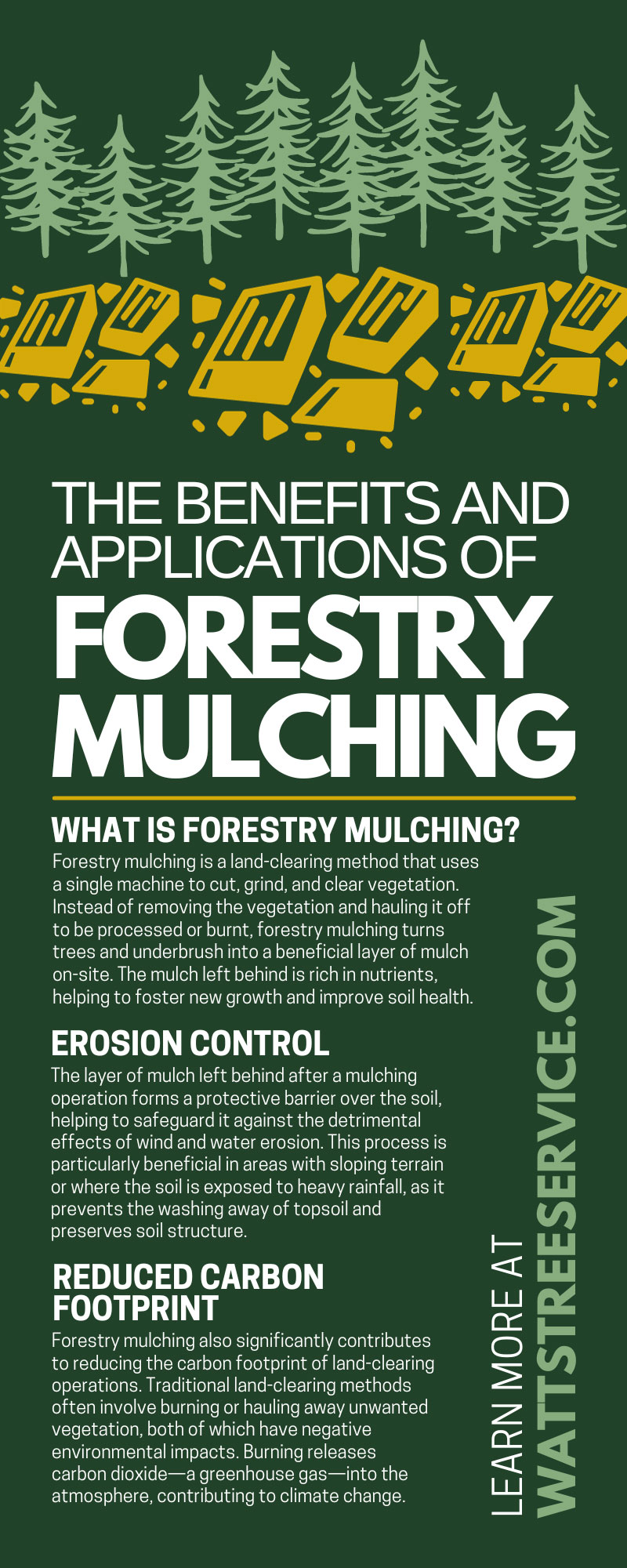Forestry mulching, an underappreciated yet invaluable tool in land management, offers numerous environmental and practical benefits. Serving a dual purpose of clearing land while enriching the soil, this technique has far-reaching applications in large-scale forestry and personal property management. Explore the benefits and applications of forestry mulching and its significant impact on sustainable land management.
What Is Forestry Mulching?
Forestry mulching is a land-clearing method that uses a single machine to cut, grind, and clear vegetation. Instead of removing the vegetation and hauling it off to be processed or burnt, forestry mulching turns trees and underbrush into a beneficial layer of mulch on-site. The mulch left behind is rich in nutrients, helping to foster new growth and improve soil health.
This environmentally friendly technique is not only efficient but also helps to control soil erosion and maintain the overall health of the land. Forestry mulching has a wide range of applications, from land preparation and maintenance to wildfire prevention and habitat restoration.
How the Process Works
Forestry mulching involves the use of a specialized machine known as a forestry mulcher. This heavy piece of equipment, often attached to a skid steer or an excavator, uses its rotating drum adorned with steel teeth or blades to shred vegetation on the ground. It starts by cutting down the trees, brush, or other vegetation, then grinds the material into tiny pieces, leaving the final product on the ground to decompose naturally.
This decomposed material acts as a nutrient-rich mulch, contributing to the fertility of the soil, promoting new plant growth, and preventing unwanted weed sprouting. The process is highly efficient and causes minimal disturbance to the ground surface, preserving the structural integrity of the soil.
Positive Impact on Soil
One of the most significant benefits of forestry mulching is its positive impact on soil health and fertility. Unlike traditional land-clearing methods that strip the soil of essential nutrients, forestry mulching turns trees and vegetation directly into mulch on-site.
This mulch is rich in organic matter, and it is distributed evenly over the soil. The consequent decomposition process releases essential nutrients back into the soil, enriching it and promoting the growth of beneficial microorganisms.
Additionally, the mulch acts as a protective layer, enhancing the soil’s water retention ability and regulating its temperature. In this way, forestry mulching contributes to sustainable land management, maintaining soil health and productivity over time.
Erosion Control
Another noteworthy benefit of forestry mulching is its ability to provide effective erosion control. The layer of mulch left behind after a mulching operation forms a protective barrier over the soil, helping to safeguard it against the detrimental effects of wind and water erosion. This process is particularly beneficial in areas with sloping terrain or where the soil is exposed to heavy rainfall, as it prevents the washing away of topsoil and preserves soil structure.
Additionally, the mulch helps slow down water runoff, allowing more time for the soil to absorb and retain water. This benefit aids in maintaining soil moisture levels and reduces the risk of flash flooding. Through these mechanisms, forestry mulching plays a critical role in preserving soil health, supporting plant growth, and promoting overall land stability.
Reduced Carbon Footprint
Forestry mulching also significantly contributes to reducing the carbon footprint of land-clearing operations. Traditional land-clearing methods often involve burning or hauling away unwanted vegetation, both of which have negative environmental impacts. Burning releases carbon dioxide—a greenhouse gas—into the atmosphere, contributing to climate change.
Hauling materials away, on the other hand, necessitates the use of additional vehicles, which also leads to increased carbon emissions. However, by turning unwanted vegetation into nutrient-rich mulch on-site, forestry mulching eliminates the need for these harmful practices. The resulting decrease in pollution and greenhouse gas emissions makes forestry mulching a far more environmentally friendly approach to land management.
Fire Prevention
Forestry mulching is pivotal for fire prevention, further solidifying its status as an effective and sustainable land management approach. Wildfires often feed on excess underbrush and dead vegetation, which act as combustible materials. Forestry mulching helps mitigate this risk by systematically removing these potential fire hazards. The mulching process converts unwanted and potentially dangerous undergrowth into beneficial mulch, thereby reducing the availability of materials that can fuel a wildfire.
This proactive approach to fire prevention is particularly vital in areas prone to wildfires, where regular forestry mulching can significantly reduce the risk and severity of these destructive events. Hence, forestry mulching promotes land health and fertility, and contributes significantly to the safety and preservation of our natural areas.
The Applications of Forestry Mulching
Thanks to its versatility and efficiency, forestry mulching has many applications in a broad spectrum of industries. One of the primary uses is in land and lot clearing for construction and development projects. This method swiftly clears the land of unwanted vegetation while leaving a nutrient-rich layer of mulch behind, preparing the ground for future use.
In agricultural settings, forestry mulching aids in reclaiming overgrown fields and pastures, turning stubborn undergrowth into beneficial soil amendments. It is also extensively used for right-of-way clearing and maintenance for roads, pipelines, and powerlines.
In the realm of environmental conservation, forestry mulching is instrumental in creating firebreaks, managing invasive species, and restoring wildlife habitats. In essence, forestry mulching is a multifaceted tool, rendering it an invaluable resource in various fields that require effective, sustainable land management techniques.
Now that you understand the applications and benefits of forestry mulching, you can determine if this is the right method for your needs. The advantages it offers, from improving soil health and controlling erosion to reducing carbon footprint and preventing wildfires, make it a remarkably effective and sustainable approach to land management. Whether you’re involved in large-scale forestry projects, residential land clearing, or environmental conservation efforts, forestry mulching could become an integral part of your land management strategy.
Contact Watts Tree Service today to learn more about our forestry mulching services. Committing to methods like forestry mulching is a step toward a more sustainable future, where we manage our resources responsibly and maintain the health and vitality of our lands.

Last modified: April 25, 2025

